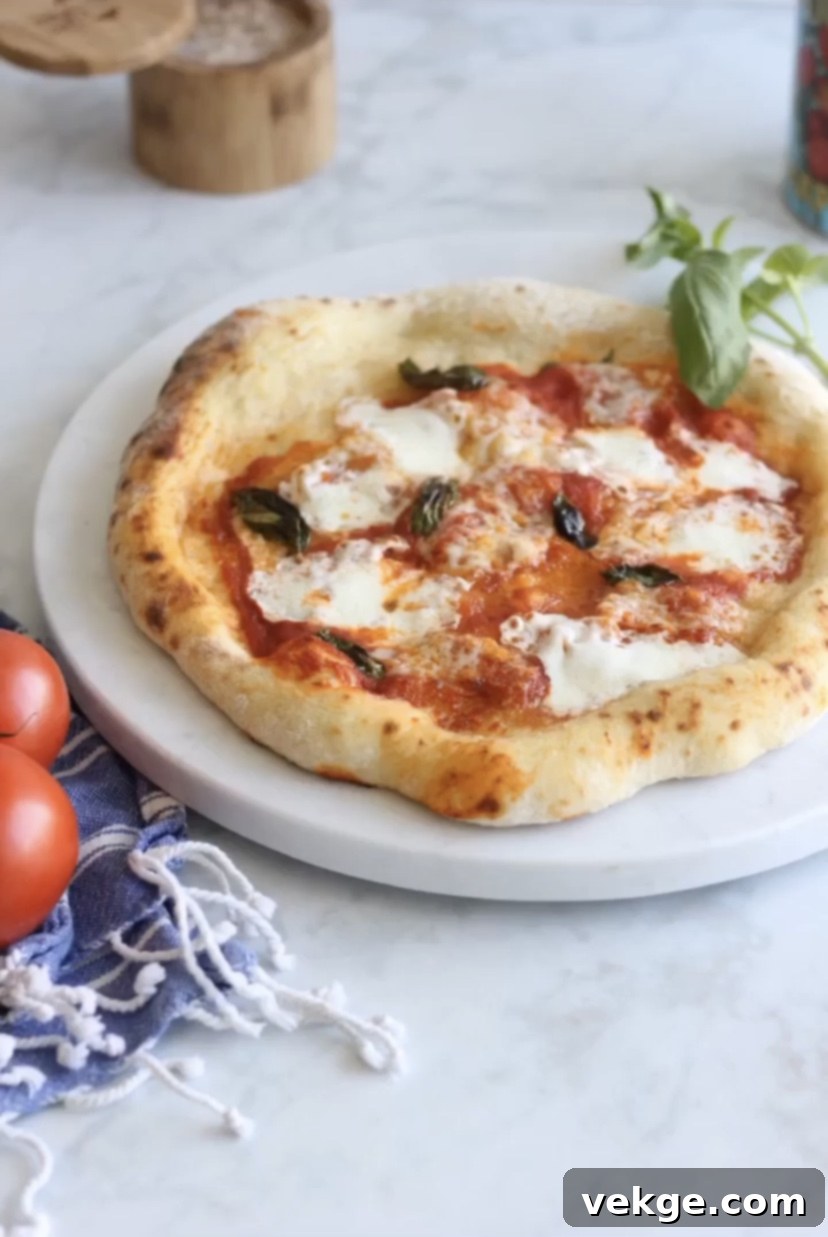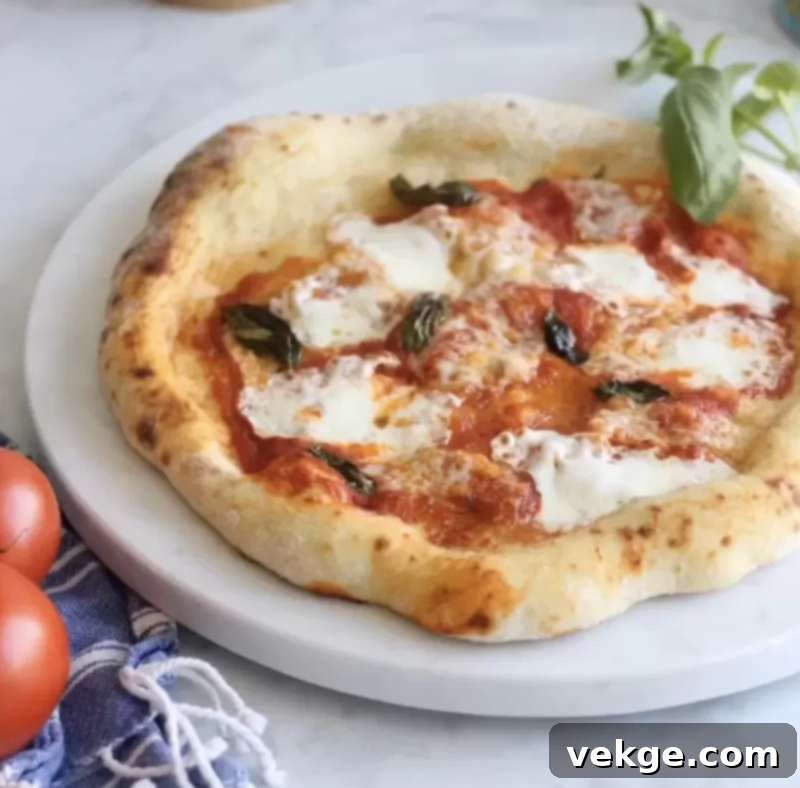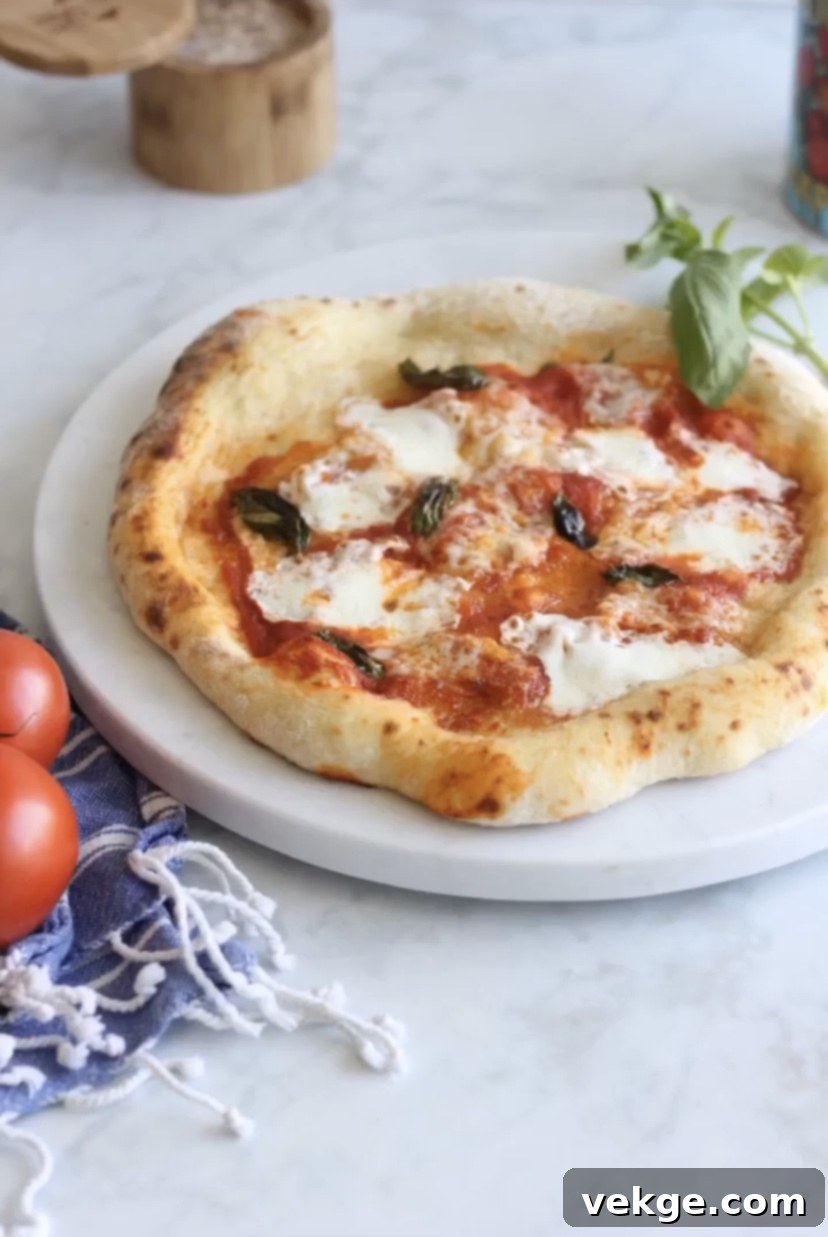Mastering Neapolitan-Style Pizza at Home: A Chef’s Guide to Perfection
Imagine biting into a slice of pizza with a perfectly charred, airy, and chewy crust, reminiscent of a true Neapolitan pie fresh from a traditional wood-fired oven. What if we told you that this culinary dream is entirely achievable in your very own home kitchen? We had the incredible opportunity to learn the secrets of crafting out-of-this-world Neapolitan-style pizza directly from the acclaimed Chef Brandon Price. He generously shared his ingenious techniques that effectively mimic the intense heat and unique cooking environment of a professional wood-fired oven, transforming everyday home cooking into an extraordinary gourmet experience.
Chef Price’s formula is more than just a recipe; it’s a comprehensive approach that encompasses precise ingredients, a meticulous method, and expert cooking tricks designed for the home baker. This isn’t just a pizza recipe; it’s your ticket to creating unforgettable culinary moments, proving that authentic, high-quality Neapolitan pizza is well within your reach. Prepare to impress yourself and your loved ones with a crust that is truly irreplaceable and flavors that transport you straight to Naples.

The Allure of Authentic Neapolitan Pizza: Why It Stands Apart
Neapolitan pizza, or Pizza Napoletana, is a revered culinary tradition originating from Naples, Italy. Its distinctive characteristics – a soft, elastic, and fragrant crust with a slightly raised edge (cornicione) that’s often beautifully charred, minimal high-quality toppings, and a quick cooking time at extreme temperatures – set it apart from other pizza styles. The magic lies in its simplicity and the integrity of its core ingredients: flour, water, salt, and yeast (or sourdough). Achieving that signature puffy, leopard-spotted crust typically requires temperatures upwards of 900°F (480°C) found in wood-fired ovens. For home cooks, this has always been the greatest challenge – until now. Chef Brandon Price’s method ingeniously bridges this gap, allowing you to replicate these conditions and textures using your standard home oven, elevating your pizza game to a professional level.
Unlocking Flavor: The Sourdough Advantage in Pizza Dough
This exceptional recipe primarily calls for sourdough discard, a fantastic way to utilize the leftover starter that might otherwise go to waste. Sourdough discard adds a depth of flavor, a unique tang, and contributes to the incredible texture of the crust that conventional yeast alone cannot achieve. It aids in creating a more complex flavor profile and a lighter, airier crumb structure. However, if you’re new to sourdough or don’t currently maintain a starter, there’s absolutely no need to fret! Chef Price’s versatile approach offers three distinct ways to prepare this phenomenal pizza dough:
- No Sourdough, Just Dry Yeast: For a simpler and quicker approach, you can achieve a delicious crust by using just 2 teaspoons of active dry yeast. This method is perfect for those who want to jump straight into pizza making without the commitment of sourdough.
- Hybrid Method (Dry Yeast + Sourdough Discard): This is the specific recipe shared by Chef Brandon Price and detailed below. It leverages the best of both worlds: the reliability and speed of dry yeast combined with the nuanced flavor and improved texture that sourdough discard brings. It’s our personal favorite for its balance of ease and complexity.
- Active Sourdough Starter (No Dry Yeast): For the purest sourdough experience, you can use 230 grams (1 cup) of active sourdough starter and omit the dry yeast entirely. Be aware that this method will require a significantly longer rise and fermentation time, often overnight or up to 24 hours, and might necessitate a slight adjustment in flour quantity to achieve the desired dough consistency. The patience required for this method is richly rewarded with an intensely flavorful and beautifully structured crust.
While all three methods yield excellent results, Chef Brandon Price’s hybrid recipe, as presented below, truly stands out. It strikes a perfect balance, offering the profound flavor and texture benefits of sourdough without the extensive waiting periods often associated with purely sourdough-leavened doughs. For those keen to delve deeper into the world of sourdough and learn the art of maintaining a vibrant starter, we highly recommend visiting our Natural Yeast Sourdough Sandwich Bread post. It’s a comprehensive guide that covers everything you need to know to cultivate your own natural yeast.


The Essential Tools for Your Home Pizza Kitchen
While Chef Price’s technique is revolutionary, having the right equipment can make all the difference in your home pizza-making journey. Here are a few essentials:
- Pizza Stone or Steel: This is arguably the most critical piece of equipment for mimicking a wood-fired oven. A pizza stone or steel retains and radiates heat incredibly well, providing the high-temperature surface needed to cook the bottom of your pizza quickly and achieve that coveted crispy, charred crust. A pizza steel heats up faster and retains heat better than a stone, but either will significantly improve your results over baking directly on an oven rack.
- Pizza Peel: A pizza peel is indispensable for transferring your assembled pizza into a scorching hot oven and safely retrieving it. Available in wood or metal, make sure to flour it generously before placing your dough on it to prevent sticking.
- High-Quality Flour: While not equipment, the right flour is key. Type ’00’ flour is traditionally used for Neapolitan pizza, known for its fine texture and low protein content, which results in a tender, chewy crust. However, a good quality bread flour can also yield excellent results.
- Large Mixing Bowl: For combining your ingredients and allowing the dough to rise.
- Dough Scraper: Useful for handling sticky dough and dividing it.
Chef Brandon Price’s Neapolitan-Style Pizza From Home Recipe

Neapolitan-Style Pizza From Home
Just like it came out of a wood-fire oven! Gourmet pizza from home. The crust is irreplaceable.
Print Recipe
Pin Recipe
Rate This Recipe
Main Course
20 minutes
5 pizzas
2-4 minutes per pizza
Approximately 2 hours 30 minutes (plus optional refrigeration time)
Ingredients
- 650 grams (just under 3 cups) lukewarm water
- 1 gram (1/2 tsp) instant yeast
- 150 grams (3/4 cup) sourdough discard
- 1000 grams (6 cups) all-purpose or ’00’ flour
- 25 grams (4 teaspoons) fine sea salt
Instructions
In a large mixing bowl, combine the lukewarm water, instant yeast, and sourdough discard. Stir gently until well combined. Gradually add the flour, mixing with your hands until a shaggy, cohesive dough forms. It should be hydrated but not overly sticky. Cover the bowl with a clean kitchen towel or plastic wrap and let it rest at room temperature for 20 minutes. This initial rest, known as autolyse, helps the flour absorb the water fully and begins gluten development.
After the rest, sprinkle the 25 grams of fine sea salt over the dough. To incorporate the salt evenly, use a “cut and crimp” or “stretch and fold” technique. Gently pull a section of the dough up from the bowl, stretch it, and fold it over itself. Repeat this action several times, rotating the bowl, until the salt is fully integrated. This process also further develops the gluten without excessive kneading. Cover the dough again and let it rest at room temperature for 2 hours for its bulk fermentation. Alternatively, for enhanced flavor development and easier handling, you can refrigerate the dough for up to 24 hours at this stage. Once the bulk fermentation is complete, gently divide the dough into 5 equal pieces (approximately 360-370 grams each for a 12-inch pizza). Roll each piece into a tight, smooth ball. Place the dough balls onto a lightly oiled baking sheet, ensuring they have space between them. Lightly oil the tops of the dough balls to prevent a skin from forming, then cover them tightly with plastic wrap. Let them rest at room temperature for 2-4 hours, or refrigerate for up to 3 days. This secondary proofing allows the dough to relax and develop even more flavor and elasticity.
Approximately 45 minutes before you plan to bake, place your pizza stone (or steel) on the top rack of your oven, about 6-8 inches from the broiler element. Preheat your oven to its highest temperature, usually 500°F (260°C). Allowing ample time for the stone to heat thoroughly is crucial for a crispy bottom crust. Don’t rush this step!
When ready to bake, lightly flour a clean work surface. Take one dough ball and gently transfer it to the floured surface. Using the palms of your hands and fingertips, start flattening the dough from the center outwards, leaving a slightly thicker rim around the edges to form the cornicione (crust). Resist the urge to use a rolling pin, as this will deflate the precious air bubbles that contribute to the Neapolitan pizza’s characteristic airy texture. Stretch the dough gently until it forms a round about 10-12 inches in diameter.
Once your dough is perfectly formed and smooth, ensure there’s enough flour underneath to prevent sticking. Now, it’s time to assemble your toppings. Remember the Neapolitan philosophy: less is more. High-quality ingredients shine brightest. Add your preferred sauce, cheese (fresh mozzarella is traditional), and other toppings sparingly. For Chef Price’s specific sauce recipe and further topping insights, refer to the accompanying video (if available). After topping, change your oven temperature setting from bake to **broil** (high setting if available). This will create the intense top-down heat needed for blistering the crust and cooking toppings quickly.
Carefully transfer the assembled pizza onto a generously floured pizza peel. A quick, confident shake of the peel will help ensure it slides smoothly. Open the preheated oven, aim for the pizza stone directly under the broiler, and with a swift motion, slide the pizza onto the stone. Close the oven door quickly to retain heat. Cook for a very short duration, typically 2-4 minutes. This part requires close attention! Watch the pizza through the oven door, rotating it once halfway through if one side is browning faster, to ensure even cooking and charring of the crust. The goal is a beautifully blistered, golden-brown crust and melted, bubbling cheese.
Using your pizza peel, carefully remove the perfectly baked pizza from the oven. Transfer it to a cutting board, slice, and serve immediately to enjoy it at its absolute best. Repeat the process with the remaining dough balls, adjusting cooking time slightly if needed based on your oven’s performance.
Notes
This recipe is designed to be highly adaptable. It calls for sourdough discard, but don’t hesitate to use one of the alternative methods if you don’t have discard readily available. Each approach offers a unique path to a fantastic homemade pizza:
1. Dry Yeast Only: If you’re opting for a faster dough, simply use 2 teaspoons of active dry yeast and omit the sourdough discard. The dough will still be excellent, though with a slightly less complex flavor.
2. Hybrid (Dry Yeast + Sourdough Discard): This is the method detailed above, offering a harmonious blend of quick rise and deep flavor.
3. Active Sourdough Starter: For a purely sourdough experience, substitute the 1 gram of instant yeast and 150 grams of sourdough discard with 230 grams (1 cup) of active, bubbly sourdough starter. Be prepared for a longer fermentation time, potentially up to 12-24 hours for the bulk rise, and you might need to add a touch more flour to achieve the desired dough consistency. This method rewards patience with unparalleled depth of flavor.
Chef Brandon Price’s Secret Tips for Achieving Wood-Fired Excellence at Home
Beyond the recipe, Chef Price emphasizes a few critical factors that elevate homemade pizza to near-professional levels:
- Maximize Oven Heat: The combination of a preheated pizza stone/steel and switching to the broiler mode is the game-changer. This simulates the extreme top and bottom heat of a wood-fired oven, creating that rapid cook and beautiful char.
- Gentle Dough Handling: Avoid overworking the dough or using a rolling pin. The goal is to preserve the air bubbles created during fermentation, which are crucial for a light, airy, and chewy crust. Hand-stretching allows for a delicate touch.
- Quality Over Quantity for Toppings: A true Neapolitan pizza is about showcasing the sublime crust and the freshness of its few, high-quality toppings. Overloading the pizza will lead to a soggy crust and uneven cooking.
- Cold Fermentation is Your Friend: While optional, refrigerating the dough for the secondary proof (up to 3 days) significantly enhances the flavor development, making the crust more complex and delicious. It also makes the dough easier to handle.
- Trust Your Eyes: Baking times are guides. Every oven is different. Watch your pizza closely, especially under the broiler, and remove it when the crust is perfectly blistered and the cheese is melted and slightly browned.
Troubleshooting Common Home Pizza Issues
Even with the best instructions, pizza making can sometimes present challenges. Here are solutions to common problems:
- Soggy Crust:
- Issue: Pizza bottom isn’t crispy.
- Solution: Ensure your pizza stone/steel is thoroughly preheated for at least 45-60 minutes. Don’t overload toppings, as excess moisture can contribute to sogginess.
- Burnt Toppings, Undercooked Crust:
- Issue: Toppings cook too fast or burn before the crust is done.
- Solution: Your broiler might be too intense or too close. Try moving the pizza stone one rack lower. You can also par-bake the plain crust for 1-2 minutes before adding toppings.
- Dough Sticking to the Peel:
- Issue: Pizza won’t slide off the peel.
- Solution: Generously flour your pizza peel before placing the dough on it. Work quickly once toppings are on to avoid the dough absorbing the flour and sticking. A quick, confident motion is key when transferring.
- Crust Not Getting Enough Char/Blistering:
- Issue: Crust is pale or lacks the characteristic “leopard spots.”
- Solution: Ensure your oven is at its highest temperature and the broiler is on. The stone should be as close to the broiler as safely possible. Your dough might also need a bit more hydration or a longer fermentation time to develop the necessary elasticity for blistering.
Beyond Basic: Serving Suggestions and Customization
While Neapolitan pizza is traditionally simple, you can certainly explore variations:
- Classic Marinara: A simple sauce made with San Marzano tomatoes, garlic, basil, and olive oil is always a winner.
- Fresh Mozzarella: Buffalo mozzarella or fresh fior di latte are ideal. Pat them dry before using to prevent excess moisture.
- Topping Ideas: Beyond the classic Margherita, consider adding thinly sliced prosciutto after baking, fresh arugula, Kalamata olives, mushrooms, or a sprinkle of Parmesan. Remember: restraint is key.
- Drizzle of Olive Oil: A finishing drizzle of high-quality extra virgin olive oil after baking enhances flavor and adds a beautiful sheen.
Your Neapolitan Pizza Journey Begins Now
Embarking on the journey of making Neapolitan-style pizza at home is a rewarding culinary adventure. With Chef Brandon Price’s expert guidance and the versatile dough options, you’re now equipped to create pizzas that rival those from Italy’s finest pizzerias. The combination of the hybrid sourdough discard method, extreme oven temperatures, and careful dough handling will undoubtedly yield a crust that is both unforgettable and irresistibly delicious. So preheat your ovens, gather your ingredients, and prepare to delight in the art of homemade Neapolitan pizza. Share your creations, experiment with toppings, and most importantly, savor every single bite of your gourmet masterpiece!
